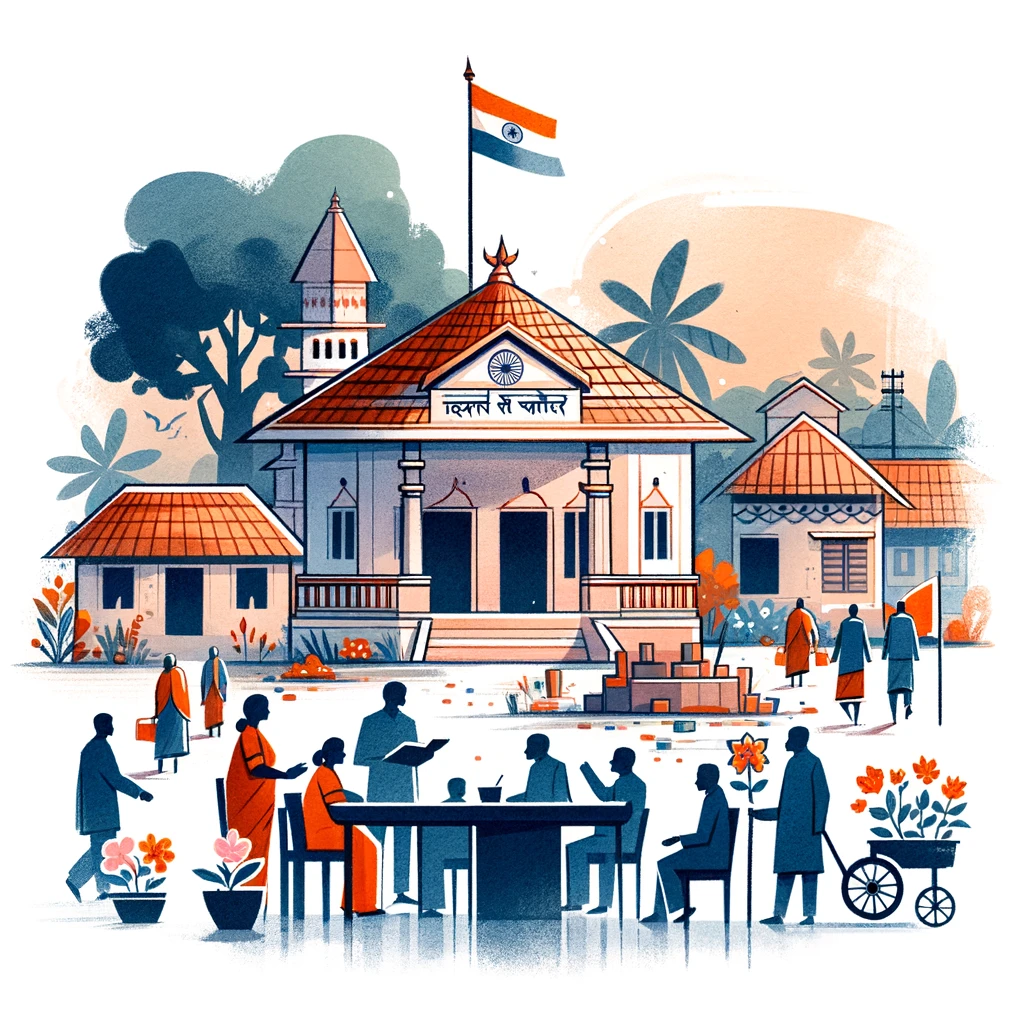Urban local bodies (ULBs) play a crucial role in managing and governing urban areas in India. They ensure the provision of essential services, infrastructure development, and overall urban governance. This article delves into the key provisions of the 74th Constitutional Amendment Act, the structure and functions of ULBs, the roles and responsibilities of key officials, urban governance setup, funding, and financial management, and the challenges and solutions for effective urban governance.

1. 74th Constitutional Amendment Act: Key Provisions and Significance
Key Provisions:
- Constitutional Status: The 74th Amendment Act of 1992 gave constitutional recognition to urban local bodies, ensuring their establishment and continuity across states.
- Types of ULBs: It introduced a three-tier system of urban governance – Municipal Corporations for large urban areas, Municipal Councils for smaller urban areas, and Nagar Panchayats for areas in transition from rural to urban.
- Elections: Mandated regular elections every five years, overseen by State Election Commissions.
- Reservation: Reserved seats for Scheduled Castes, Scheduled Tribes, and women (one-third of the seats) to ensure representation.
- Powers and Responsibilities: Enumerated 18 functions under the Twelfth Schedule that could be devolved to ULBs by state governments.
- Finance: Established State Finance Commissions to recommend measures to improve the financial position of ULBs.
Significance:
- Empowerment: Empowered urban local bodies with authority and responsibility, promoting decentralized urban governance.
- Inclusivity: Ensured representation for marginalized communities and women in urban governance.
- Accountability: Enhanced accountability and transparency in urban administration through regular elections and defined roles.

2. Structure and Functions of Urban Local Bodies: Municipalities, Municipal Councils, and Municipal Corporations
Municipal Corporations:
- Structure: Governed by elected representatives, including the Mayor and Councillors. It is headed by a Municipal Commissioner appointed by the state government.
- Functions: Responsible for providing and maintaining urban infrastructure, sanitation, water supply, public health, education, and urban planning.
Municipal Councils:
- Structure: Similar to Municipal Corporations but for smaller urban areas. It includes an elected body headed by a Chairperson and Councillors.
- Functions: Focus on local urban management, including basic amenities, public health, and community services.
Nagar Panchayats:
- Structure: Governed by an elected body, including a Chairperson and members, for areas transitioning from rural to urban.
- Functions: Manage local development, basic services, and infrastructure improvements.
3. Roles and Responsibilities of Mayors and Municipal Commissioners
Mayors:
- Role: The Mayor is the ceremonial head of the Municipal Corporation and represents it in official functions.
- Responsibilities:
- Presiding over meetings of the Municipal Corporation.
- Ensuring the implementation of council decisions.
- Representing the municipality in civic events and functions.
- Acting as a liaison between the municipal administration and the public.
Municipal Commissioners:
- Role: The Municipal Commissioner is the executive head of the Municipal Corporation, responsible for day-to-day administration.
- Responsibilities:
- Implementing policies and decisions made by the Municipal Corporation.
- Managing municipal staff and operations.
- Ensuring efficient delivery of services such as sanitation, water supply, and infrastructure maintenance.
- Preparing and managing the municipal budget.
- Coordinating with state government agencies for urban development projects.
4. Urban Governance and Administrative Setup
Administrative Setup:
- Hierarchy: Urban local bodies operate within a hierarchical framework, with the Municipal Commissioner at the top, followed by other officers and municipal staff.
- Departments: ULBs are organized into various departments such as health, education, engineering, finance, and urban planning, each managed by respective heads.
- Coordination: Coordination among departments is essential for effective governance and service delivery.
Urban Governance:
- Policy Making: Municipal bodies formulate policies for local governance and development.
- Service Delivery: Ensure the provision of essential services like water supply, sanitation, and waste management.
- Urban Planning: Plan and implement urban development projects, infrastructure, and land use.
- Public Participation: Encourage citizen participation in governance through ward committees, public hearings, and consultations.
5. Funding and Financial Management in Urban Local Bodies
Funding Sources:
- Own Revenue: Generated through property taxes, user charges, fees, and fines.
- Grants: Received from the state and central governments for specific projects and general development.
- Loans and Borrowings: Raised from financial institutions for infrastructure development.
- Public-Private Partnerships (PPPs): Collaborations with private entities for funding and executing urban projects.
Financial Management:
- Budget Preparation: Annual budgets are prepared, detailing expected revenue and planned expenditures.
- Expenditure Management: Efficient allocation and utilization of funds for various services and projects.
- Financial Audits: Regular audits are needed to ensure transparency and accountability in financial transactions.
- State Finance Commissions: Recommendations from these commissions help improve financial health and resource distribution.
6. Challenges and Solutions for Effective Urban Governance
Challenges:
- Resource Constraints: Limited financial and human resources hinder effective service delivery.
- Urbanization Pressure: Rapid urbanization leads to increased demand for services and infrastructure, often outpacing capacity.
- Inefficiency and Corruption: Bureaucratic inefficiencies and corruption can undermine governance and public trust.
- Coordination Issues: Lack of coordination among different departments and agencies affects integrated urban planning.
- Inadequate Infrastructure: Aging and insufficient infrastructure hamper urban growth and development.
Solutions:
- Capacity Building: Training and capacity-building programs for municipal staff and elected representatives.
- Resource Mobilization: Enhancing revenue generation through better tax collection and innovative financing mechanisms.
- Public Participation: Increasing citizen involvement in decision-making and governance processes.
- Transparency and Accountability: Implementing robust systems for transparency, accountability, and anti-corruption measures.
- Integrated Planning: Promoting coordinated and comprehensive urban planning involving all stakeholders.
Conclusion:
Urban local bodies, through Municipal Corporations, Municipal Councils, and Nagar Panchayats, play a vital role in managing India’s urban areas. Understanding the provisions of the 74th Constitutional Amendment, the structure, functions, roles of key officials, governance setup, funding, and challenges is crucial for effective urban administration. For UPSC aspirants, a deep knowledge of these aspects is essential for a comprehensive understanding of urban governance and administration, which forms a significant part of the polity and governance syllabus.



